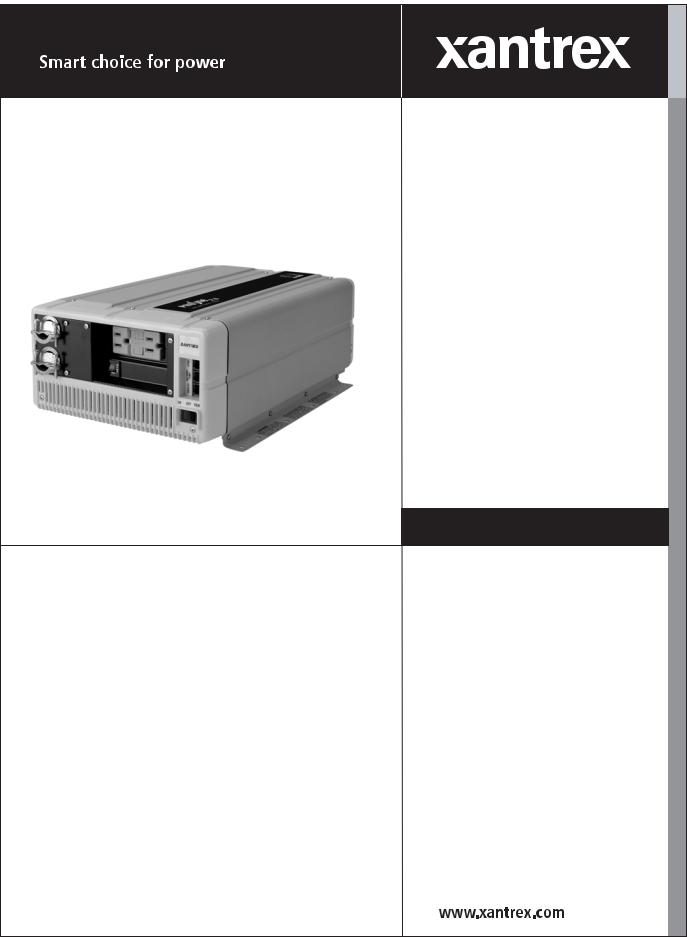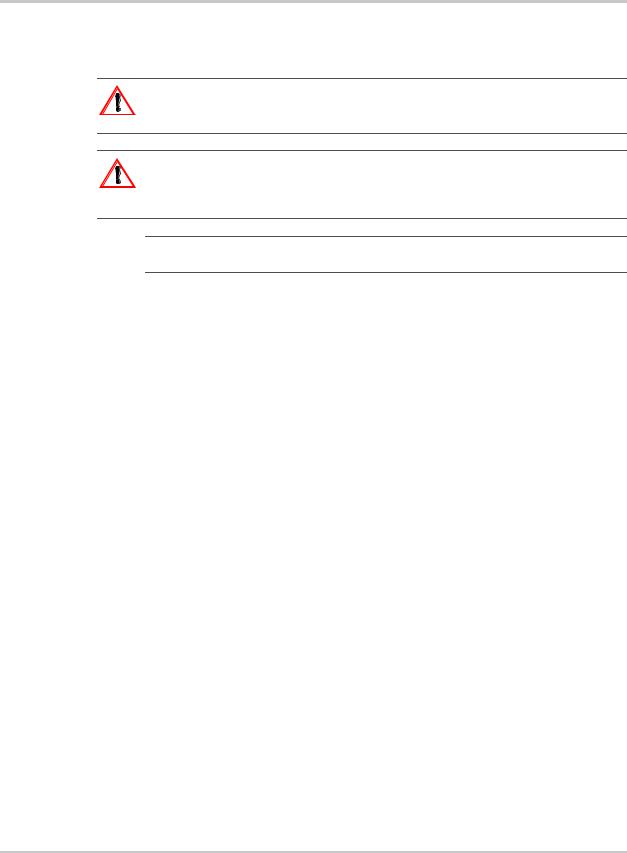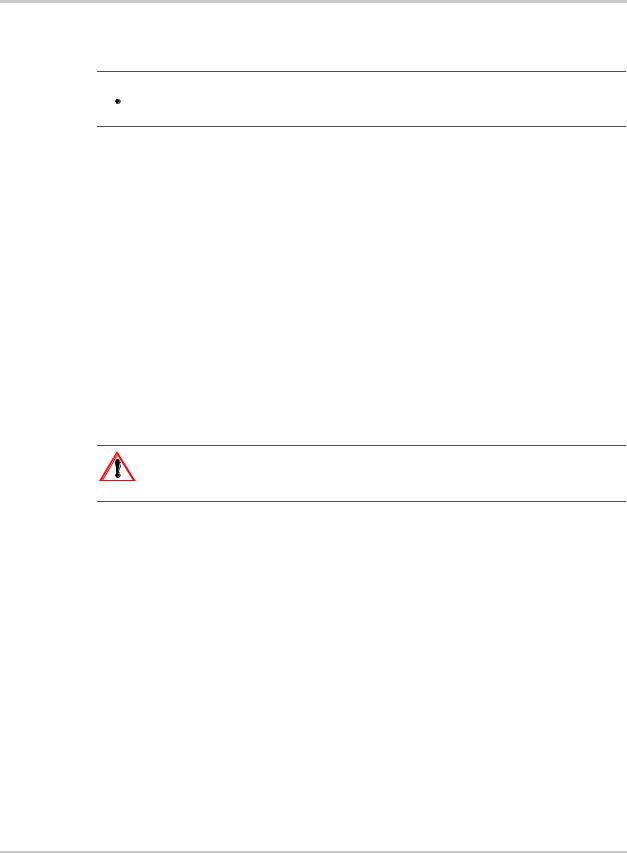Xantrex Technology PROsine 2.0 User Manual

User’s Manual
PROsine 2.0
Inverter/Charger

PROsine 2.0 Inverter/Charger
User’s Manual
About Xantrex
Xantrex Technology Inc. is a world-leading supplier of advanced power electronics and controls with products from 50 watt mobile units to one MW utility-scale systems for wind, solar, batteries, fuel cells, microturbines, and backup power applications in both grid-connected and stand-alone systems. Xantrex products include inverters, battery chargers, programmable power supplies, and variable speed drives that convert, supply, control, clean, and distribute electrical power.
Trademarks
PROsine 2.0 Inverter/Charger is a trademark of Xantrex International. Xantrex is a registered trademark of Xantrex International.
Other trademarks, registered trademarks, and product names are the property of their respective owners and are used herein for identification purposes only.
Notice of Copyright
PROsine 2.0 Inverter/Charger User’s Manual © November 2006 Xantrex International. All rights reserved.
Exclusion for Documentation
UNLESS SPECIFICALLY AGREED TO IN WRITING, XANTREX TECHNOLOGY INC. (“XANTREX”)
(a)MAKES NO WARRANTY AS TO THE ACCURACY, SUFFICIENCY OR SUITABILITY OF ANY TECHNICAL OR OTHER INFORMATION PROVIDED IN ITS MANUALS OR OTHER DOCUMENTATION.
(b)ASSUMES NO RESPONSIBILITY OR LIABILITY FOR LOSSES, DAMAGES, COSTS OR EXPENSES, WHETHER SPECIAL, DIRECT, INDIRECT, CONSEQUENTIAL OR INCIDENTAL, WHICH MIGHT ARISE OUT OF THE USE OF SUCH INFORMATION. THE USE OF ANY SUCH INFORMATION WILL BE ENTIRELY AT THE USER’S RISK; AND
(c)REMINDS YOU THAT IF THIS MANUAL IS IN ANY LANGUAGE OTHER THAN ENGLISH, ALTHOUGH STEPS HAVE BEEN TAKEN TO MAINTAIN THE ACCURACY OF THE TRANSLATION, THE ACCURACY CANNOT BE GUARANTEED. APPROVED XANTRES CONTENT IS CONTAINED WITH THE ENGLISH LANGUAGE VERSION WHICH IS POSTED AT WWW.XANTREX.COM.
Date and Revision
November 2006 Revision C
Part Number
445-0089-01-01
Product Number
805-2000, 805-2020
Contact Information
Telephone: |
1 800 670 0707 |
(toll free North America) |
|
1 360 925 5097 |
(direct) |
Fax: |
1 800 994 7828 |
(toll free North America) |
|
1 360 925 5143 |
(direct) |
Email: |
customerservice@xantrex.com |
|
Web: |
www.xantrex.com |
|

About This Manual
Purpose
The purpose of this User’s Manual is to provide explanations and procedures for installing, operating, maintaining, and troubleshooting the PROsine 2.0 Inverter/ Charger.
Scope
The Manual provides safety guidelines, detailed planning and setup information, procedures for installing the inverter, as well as information about operating and troubleshooting the unit. It does not provide details about particular brands of batteries. You need to consult individual battery manufacturers for this information.
Audience
The Manual is intended for anyone who needs to install and operate the PROsine 2.0 Inverter/Charger. Installers should be certified technicians or electricians.
Organization
This Manual is organized into seven chapters and three appendixes:
Introduction: Chapter 1 introduces you to the PROsine, explains the inverting, changing and power system management functions
Product Orientation: Chapter 2 will familiarize you with the following components of a PROsine system:
Installation: Chapter 3 This section gives complete information for installing a PROsine system.
Configuration: Chapter 4 explains how to configure the PROsine to best meet your electrical system requirements. It is divided into three parts:
Operation: Chapter 5 begins with a system startup check that you carry out after installation and configuration to verify that the PROsine is operating correctly. The chapter also provides information that will guide you during routine, ongoing operations.
Troubleshooting: Chapter 6 describes how to troubleshoot the PROsine
Series Operation: Chapter 7 provides information about installing and operating two PROsines in series:
445-0089-01-01 |
iii |

About This Manual
Specifications: Appendix A contains specifications and performance graphs for the PROsine and the display panel.
System Diagrams: Appendix B illustrates typical designs for PROsine customdesigned systems.
Charging Algorithms: Appendix C provides information about the charging algorithms for PROsine 2.0.
iv |
445-0089-01-01 |

About This Manual
Conventions Used
The following conventions are used in this guide.
WARNING
Warnings identify conditions or practices that could result in personal injury or loss of life
CAUTION
Cautions identify conditions or practices that could result in damage to the unit or other equipment.
Important: These notes describe things which are important for you to know, but not as serious as a caution or warning.
Abbreviations and Acronyms
<just the common ones--don’t make the list too long. If there are lots, then create an appendix to contain them>
Related Documents
PROsine 2.0 Inverter/Charger Quick Installation Guide
Part Number: 445-0099-01-01: This document is included with your PROsine. It is a job aid that provides instructions for installing the PROsine and its display panel. It also provides a mounting template for the PROsine.
PROsine 2.0 Inverter/Charger Display Panel Mounting Template Part Number: 445-0101-01-01: This is provided with your PROsine.
PROsine 2.0 Inverter/Charger Quick Reference Guide
Part Number: 445-0100-01-01: This document is included with your PROsine. It provides frequently used information about configuring and operating the unit as well as system default values.
Related Information
You can find more information about Xantrex Technology Inc. as well as its products and services at www.xantrex.com
445-0089-01-01 |
v |
vi

Important Safety Instructions
WARNING
This chapter contains important safety and operating instructions. Read and keep this
User’s Manual for future reference.
WARNING:Limitations on use
The PROsine 2.0 Inverter/Charger is not intended for use in connection with life support systems or other medical equipment or devices.
1.Before installing and using the PROsine 2.0 Inverter/Charger (PROsine), read all instructions and cautionary markings on the PROsine, the batteries, and all appropriate sections of this Manual.
2.Do not expose the PROsine to rain, snow, spray, or bilge water. To reduce risk of fire hazard, do not cover or obstruct the ventilation openings. Do not install the PROsine in a zero-clearance compartment. Overheating may result.
3.Use only attachments recommended or sold by the manufacturer. Doing otherwise may result in a risk of fire, electric shock, or injury to persons.
4.The PROsine is designed to be permanently connected to you AC and DC electrical systems. Xantrex recommends that all wiring be done by a certified technician or electrician to ensure adherence to proper electrical wiring regulations.
5.To avoid a risk of fire and electric shock, make sure that existing wiring is in good condition and that wire is not undersized. Do not operate the PROsine with damaged or substandard wiring.
6.Do not operate the PROsine if it has received a sharp blow, been dropped, or otherwise damaged in any way. If the PROsine is damaged, see the Warranty section.
7.Do not disassemble the PROsine. It contains no user-serviceable parts. See the Warranty section for instructions on obtaining service. Attempting to service the PROsine yourself may result in a risk of electrical shock or fire. Internal capacitors remain charged after all power is disconnected.
8.To reduce the risk of electrical shock, disconnect both AC and DC power from the PROsine before attempting any maintenance or cleaning or working on any circuits connected to the PROsine. Turning off controls will not reduce this risk.
9.The PROsine must be provided with an equipment-grounding conductor connected to the AC input ground terminal. Grounding and all other wiring must comply with local codes and ordinances.
445-0089-01-01 |
vii |

Safety
Explosive gas precautions
 WARNING: Explosion hazard
WARNING: Explosion hazard
1.Working in the vicinity of lead-acid batteries is dangerous. Batteries generate explosive gases during normal operation. Therefore, you must read this guide and follow the instructions exactly before installing or using your PROsine.
2.This equipment contains components which tend to produce arcs or sparks. To prevent fire or explosion, do not install the PROsine in compartments containing batteries or flammable materials, or in locations that require ignition-protected equipment. This includes any space containing gasolinepowered machinery, fuel tanks, as well as joints, fittings, or other connections between components of the fuel system.
3.To reduce the risk of battery explosion, follow these instructions and those published by the battery manufacturer and the manufacturer of the equipment in which the battery is installed.
Precautions When Working With Batteries
WARNING: Explosion or fire hazard
1.Follow all instructions published by the battery manufacturer and the manufacturer of the equipment in which the battery is installed.
2.Make sure the area around the battery is well ventilated.
3.Never smoke or allow a spark or flame near the engine or batteries.
4.Use caution to reduce the risk or dropping a metal tool on the battery. It could spark or short circuit the battery or other electrical parts and could cause an explosion.
5.Remove all metal items, like rings, bracelets, and watches when working with lead-acid batteries. Lead-acid batteries produce a short circuit current high enough to weld metal to skin, causing a severe burn.
6.Have someone within range of your voice or close enough to come to your aid when you work near a lead-acid battery.
7.Have plenty of fresh water and soap nearby in case battery acid contacts skin, clothing, or eyes.
8.Wear complete eye protection and clothing protection. Avoid touching your eyes while working near batteries.
viii |
445-0089-01-01 |

Safety
9.If battery acid contacts skin or clothing, wash immediately with soap and water. If acid enters your eye, immediately flood it with running cold water for at least twenty minutes and get medical attention immediately.
10.If you need to remove a battery, always remove the ground terminal from the battery first. Make sure all accessories are off so you don’t cause a spark.
445-0089-01-01 |
ix |
x

Contents
Important Safety Instructions - - - - - - - - - - - - - - - - - - - - - - - - - - - - - - - - - - - - - - - - - - -vii
1 Introduction
Your PROsine- - - - - - - - - - - - - - - - - - - - - - - - - - - - - - - - - - - - - - - - - - - - - - - - - - - - - - - - - 1–2 The Heart of a Sophisticated, Independent Power System - - - - - - - - - - - - - - - - - - - - - - - - - - - 1–3 Inverting - - - - - - - - - - - - - - - - - - - - - - - - - - - - - - - - - - - - - - - - - - - - - - - - - - - - - - - - - - 1–3 Charging - - - - - - - - - - - - - - - - - - - - - - - - - - - - - - - - - - - - - - - - - - - - - - - - - - - - - - - - - - 1–4 Power System Management - - - - - - - - - - - - - - - - - - - - - - - - - - - - - - - - - - - - - - - - - - - - - 1–5 Materials List - - - - - - - - - - - - - - - - - - - - - - - - - - - - - - - - - - - - - - - - - - - - - - - - - - - - - - - - - 1–6 Default Values for the PROsine System - - - - - - - - - - - - - - - - - - - - - - - - - - - - - - - - - - - - - - - 1–9
2 Product Orientation
PROsine Features - - - - - - - - - - - - - - - - - - - - - - - - - - - - - - - - - - - - - - - - - - - - - - - - - - - - - - 2–2
AC End - - - - - - - - - - - - - - - - - - - - - - - - - - - - - - - - - - - - - - - - - - - - - - - - - - - - - - - - - - 2–2
AC Panel Options - - - - - - - - - - - - - - - - - - - - - - - - - - - - - - - - - - - - - - - - - - - - - - - - - - - 2–3
DC End - - - - - - - - - - - - - - - - - - - - - - - - - - - - - - - - - - - - - - - - - - - - - - - - - - - - - - - - - - 2–4
DC Terminal Covers - - - - - - - - - - - - - - - - - - - - - - - - - - - - - - - - - - - - - - - - - - - - - - - 2–5
Display Panel Features - - - - - - - - - - - - - - - - - - - - - - - - - - - - - - - - - - - - - - - - - - - - - - - - - - - 2–6
DISPLAY Mode Switch - - - - - - - - - - - - - - - - - - - - - - - - - - - - - - - - - - - - - - - - - - - - 2–7
INVERTER Switch - - - - - - - - - - - - - - - - - - - - - - - - - - - - - - - - - - - - - - - - - - - - - - - 2–8
INVERTER LEDs - - - - - - - - - - - - - - - - - - - - - - - - - - - - - - - - - - - - - - - - - - - - - - - - 2–8
CHARGER Switch - - - - - - - - - - - - - - - - - - - - - - - - - - - - - - - - - - - - - - - - - - - - - - - - 2–9
CHARGER LEDs - - - - - - - - - - - - - - - - - - - - - - - - - - - - - - - - - - - - - - - - - - - - - - - - - 2–9
LCD Panel - - - - - - - - - - - - - - - - - - - - - - - - - - - - - - - - - - - - - - - - - - - - - - - - - - - - 2–10
Data Display Mode - - - - - - - - - - - - - - - - - - - - - - - - - - - - - - - - - - - - - - - - - - - - - - - 2–10
Configuration Mode - - - - - - - - - - - - - - - - - - - - - - - - - - - - - - - - - - - - - - - - - - - - - - 2–10
Menu Navigation and Data Selection Buttons - - - - - - - - - - - - - - - - - - - - - - - - - - - - - 2–11
Battery Temperature Sensor - - - - - - - - - - - - - - - - - - - - - - - - - - - - - - - - - - - - - - - - - - - - - - 2–12
3 Installation
Safety Instructions - - - - - - - - - - - - - - - - - - - - - - - - - - - - - - - - - - - - - - - - - - - - - - - - - - - - - - 3–2 Installation Codes - - - - - - - - - - - - - - - - - - - - - - - - - - - - - - - - - - - - - - - - - - - - - - - - - - - - 3–2 Installation Tools and Materials - - - - - - - - - - - - - - - - - - - - - - - - - - - - - - - - - - - - - - - - - - 3–3 Installation Procedures - - - - - - - - - - - - - - - - - - - - - - - - - - - - - - - - - - - - - - - - - - - - - - - - 3–3 Step 1: Designing the Installation- - - - - - - - - - - - - - - - - - - - - - - - - - - - - - - - - - - - - - - - - - - - 3–4 Step 2: Choosing a Location for the PROsine- - - - - - - - - - - - - - - - - - - - - - - - - - - - - - - - - - - - 3–9 Step 3: Mounting the PROsine- - - - - - - - - - - - - - - - - - - - - - - - - - - - - - - - - - - - - - - - - - - - - 3–10
445-0089-01-01 |
xi |

Contents
Step 4: Connecting the AC Input Wires - - - - - - - - - - - - - - - - - - - - - - - - - - - - - - - - - - - - - - - |
3–11 |
General AC Wiring Considerations - - - - - - - - - - - - - - - - - - - - - - - - - - - - - - - - - - - - - - - |
3–11 |
AC Input Connections - - - - - - - - - - - - - - - - - - - - - - - - - - - - - - - - - - - - - - - - - - - - - |
3–12 |
Step 5: Configuring the Output Neutral Bonding System - - - - - - - - - - - - - - - - - - - - - - - - - - - |
3–13 |
AC Output Neutral-to-Ground Bonding System - - - - - - - - - - - - - - - - - - - - - - - - - - - - |
3–13 |
Step 6: Connecting the AC Output Wires - - - - - - - - - - - - - - - - - - - - - - - - - - - - - - - - - - - - - - |
3–15 |
Connections for Hardwire Option - - - - - - - - - - - - - - - - - - - - - - - - - - - - - - - - - - - - - - - - |
3–15 |
Connections for Single Hardwire Output With GFCI - - - - - - - - - - - - - - - - - - - - - - - - - - - |
3–16 |
Step 7: Connecting the DC Cables- - - - - - - - - - - - - - - - - - - - - - - - - - - - - - - - - - - - - - - - - - - |
3–17 |
DC Grounding - - - - - - - - - - - - - - - - - - - - - - - - - - - - - - - - - - - - - - - - - - - - - - - - - - |
3–19 |
Step 8: Mounting the Display Panel- - - - - - - - - - - - - - - - - - - - - - - - - - - - - - - - - - - - - - - - - - |
3–20 |
Step 9: Connecting the Battery Temperature Sensor- - - - - - - - - - - - - - - - - - - - - - - - - - - - - - - |
3–21 |
Mounting Options - - - - - - - - - - - - - - - - - - - - - - - - - - - - - - - - - - - - - - - - - - - - - - - - |
3–21 |
Mounting to the Negative Battery Terminal - - - - - - - - - - - - - - - - - - - - - - - - - - - - - - - |
3–21 |
Mounting to the Side of the Battery Case - - - - - - - - - - - - - - - - - - - - - - - - - - - - - - - - |
3–23 |
Step 10: Connecting the Remote Shutdown - - - - - - - - - - - - - - - - - - - - - - - - - - - - - - - - - - - - |
3–24 |
Installation Steps - - - - - - - - - - - - - - - - - - - - - - - - - - - - - - - - - - - - - - - - - - - - - - - - - |
3–24 |
Next Steps - - - - - - - - - - - - - - - - - - - - - - - - - - - - - - - - - - - - - - - - - - - - - - - - - - - - - - - - |
3–25 |
4 Configuration
Part 1: General Configuration Information - - - - - - - - - - - - - - - - - - - - - - - - - - - - - - - - - - - - - 4–2 Entering Configure Mode - - - - - - - - - - - - - - - - - - - - - - - - - - - - - - - - - - - - - - - - - - - - - - 4–2 Entering Installer-Only Mode - - - - - - - - - - - - - - - - - - - - - - - - - - - - - - - - - - - - - - - - - - - 4–2 Changing Settings - - - - - - - - - - - - - - - - - - - - - - - - - - - - - - - - - - - - - - - - - - - - - - - - 4–3 Resetting to Factory Defaults - - - - - - - - - - - - - - - - - - - - - - - - - - - - - - - - - - - - - - - - - - - 4–4 Part 2: Configuration Menus and Screens - - - - - - - - - - - - - - - - - - - - - - - - - - - - - - - - - - - - - - 4–4 Part 3: Configuration Options- - - - - - - - - - - - - - - - - - - - - - - - - - - - - - - - - - - - - - - - - - - - - - 4–6 Clear Errors in PROsine - - - - - - - - - - - - - - - - - - - - - - - - - - - - - - - - - - - - - - - - - - - - - - - 4–6 Configure PROsine—Basic Menu - - - - - - - - - - - - - - - - - - - - - - - - - - - - - - - - - - - - - - - - 4–7 Menu Choices or Information Displayed - - - - - - - - - - - - - - - - - - - - - - - - - - - - - - - - - 4–7 Configure PROsine—Advanced Menu - - - - - - - - - - - - - - - - - - - - - - - - - - - - - - - - - - - - - 4–8 Menu Choices or Information Displayed - - - - - - - - - - - - - - - - - - - - - - - - - - - - - - - - - 4–8 Configure Display Panel Menu - - - - - - - - - - - - - - - - - - - - - - - - - - - - - - - - - - - - - - - - - -4–11 Menu Choices or Information Displayed - - - - - - - - - - - - - - - - - - - - - - - - - - - - - - - - -4–11 Configure Battery Menu - - - - - - - - - - - - - - - - - - - - - - - - - - - - - - - - - - - - - - - - - - - - - - -4–12 Menu Choices or Information Displayed - - - - - - - - - - - - - - - - - - - - - - - - - - - - - - - - -4–13 Diagnostics Menu - - - - - - - - - - - - - - - - - - - - - - - - - - - - - - - - - - - - - - - - - - - - - - - - - - -4–17 Menu Choices or Information Displayed - - - - - - - - - - - - - - - - - - - - - - - - - - - - - - - - -4–17 Next Steps - - - - - - - - - - - - - - - - - - - - - - - - - - - - - - - - - - - - - - - - - - - - - - - - - - - - - - - -4–18
xii |
445-0089-01-01 |

Contents
5 Operation
Part 1: System Startup Check - - - - - - - - - - - - - - - - - - - - - - - - - - - - - - - - - - - - - - - - - - - - - - 5–2 Part 2: Operating Considerations - - - - - - - - - - - - - - - - - - - - - - - - - - - - - - - - - - - - - - - - - - - - 5–3 Fan Operation - - - - - - - - - - - - - - - - - - - - - - - - - - - - - - - - - - - - - - - - - - - - - - - - - - - - - - 5–3 ON/OFF/REMote Control of PROsine Operation - - - - - - - - - - - - - - - - - - - - - - - - - - - - - - 5–3 Hysteresis - - - - - - - - - - - - - - - - - - - - - - - - - - - - - - - - - - - - - - - - - - - - - - - - - - - - - - - - - 5–3 Part 3: Operation in Inverter Mode - - - - - - - - - - - - - - - - - - - - - - - - - - - - - - - - - - - - - - - - - - - 5–5 Load Sensing Mode - - - - - - - - - - - - - - - - - - - - - - - - - - - - - - - - - - - - - - - - - - - - - - - - - - 5–5 Operating Limits for Inverter Operation - - - - - - - - - - - - - - - - - - - - - - - - - - - - - - - - - - - - - 5–5 Power Output - - - - - - - - - - - - - - - - - - - - - - - - - - - - - - - - - - - - - - - - - - - - - - - - - - - - 5–5 Input Voltage - - - - - - - - - - - - - - - - - - - - - - - - - - - - - - - - - - - - - - - - - - - - - - - - - - - - 5–6
Part 4: Operation in Charger Mode- - - - - - - - - - - - - - - - - - - - - - - - - - - - - - - - - - - - - - - - - - - 5–7 Operation in Equalization Mode - - - - - - - - - - - - - - - - - - - - - - - - - - - - - - - - - - - - - - - - - - 5–7 Equalization Procedure - - - - - - - - - - - - - - - - - - - - - - - - - - - - - - - - - - - - - - - - - - - - - 5–8 Operating Limits for Charger Operation - - - - - - - - - - - - - - - - - - - - - - - - - - - - - - - - - - - - - 5–9 Power Share - - - - - - - - - - - - - - - - - - - - - - - - - - - - - - - - - - - - - - - - - - - - - - - - - - - - - - - 5–9 Part 5: Display Mode Screens - - - - - - - - - - - - - - - - - - - - - - - - - - - - - - - - - - - - - - - - - - - - - 5–10
6 Troubleshooting
General Troubleshooting Guidelines- - - - - - - - - - - - - - - - - - - - - - - - - - - - - - - - - - - - - - - - - - 6–2
Shutdown / Restart Without Error Message - - - - - - - - - - - - - - - - - - - - - - - - - - - - - - - - - - 6–3
Resetting PROsine Operation - - - - - - - - - - - - - - - - - - - - - - - - - - - - - - - - - - - - - - - - - - - - 6–3
AC Bad Causes - - - - - - - - - - - - - - - - - - - - - - - - - - - - - - - - - - - - - - - - - - - - - - - - - - - - - 6–3
Warning Messages- - - - - - - - - - - - - - - - - - - - - - - - - - - - - - - - - - - - - - - - - - - - - - - - - - - - - - 6–4
Error Messages - - - - - - - - - - - - - - - - - - - - - - - - - - - - - - - - - - - - - - - - - - - - - - - - - - - - - - - - 6–6
Display Panel Faults - - - - - - - - - - - - - - - - - - - - - - - - - - - - - - - - - - - - - - - - - - - - - - - - - - - - 6–9
Unexplained Faults - - - - - - - - - - - - - - - - - - - - - - - - - - - - - - - - - - - - - - - - - - - - - - - - - - - - 6–10
Inverter Applications - - - - - - - - - - - - - - - - - - - - - - - - - - - - - - - - - - - - - - - - - - - - - - - - - - - 6–11
Resistive Loads - - - - - - - - - - - - - - - - - - - - - - - - - - - - - - - - - - - - - - - - - - - - - - - - - - - - 6–11
Motor Loads - - - - - - - - - - - - - - - - - - - - - - - - - - - - - - - - - - - - - - - - - - - - - - - - - - - - - - 6–11
Long Transfer Times - - - - - - - - - - - - - - - - - - - - - - - - - - - - - - - - - - - - - - - - - - - - - - - - 6–11
Problem Loads - - - - - - - - - - - - - - - - - - - - - - - - - - - - - - - - - - - - - - - - - - - - - - - - - - - - - 6–12
7 Series Operation
Designing a Series System - - - - - - - - - - - - - - - - - - - - - - - - - - - - - - - - - - - - - - - - - - - - - - - - 7–2
System Overview - - - - - - - - - - - - - - - - - - - - - - - - - - - - - - - - - - - - - - - - - - - - - - - - - 7–2
System Components - - - - - - - - - - - - - - - - - - - - - - - - - - - - - - - - - - - - - - - - - - - - - - - 7–2
AC Input - - - - - - - - - - - - - - - - - - - - - - - - - - - - - - - - - - - - - - - - - - - - - - - - - - - - - - - 7–4
AC Output - - - - - - - - - - - - - - - - - - - - - - - - - - - - - - - - - - - - - - - - - - - - - - - - - - - - - - 7–4
Battery Disconnect and Over-Current Protection Requirements - - - - - - - - - - - - - - - - - - 7–4
Series Sync Connection - - - - - - - - - - - - - - - - - - - - - - - - - - - - - - - - - - - - - - - - - - - - - 7–4
445-0089-01-01 |
xiii |

Contents
Installing a Series System - - - - - - - - - - - - - - - - - - - - - - - - - - - - - - - - - - - - - - - - - - - - - - - - 7–5 Connecting AC Input Wiring - - - - - - - - - - - - - - - - - - - - - - - - - - - - - - - - - - - - - - - - - 7–5 Connecting AC Output Wiring - - - - - - - - - - - - - - - - - - - - - - - - - - - - - - - - - - - - - - - 7–6 Configuring the Inverter Output Neutral Bonding - - - - - - - - - - - - - - - - - - - - - - - - - - - 7–6 Connecting the DC Cables - - - - - - - - - - - - - - - - - - - - - - - - - - - - - - - - - - - - - - - - - - 7–6 Connecting the DC Ground - - - - - - - - - - - - - - - - - - - - - - - - - - - - - - - - - - - - - - - - - - 7–7 Installing the Display Panels - - - - - - - - - - - - - - - - - - - - - - - - - - - - - - - - - - - - - - - - - 7–7 Installing the Battery Temperature Sensors - - - - - - - - - - - - - - - - - - - - - - - - - - - - - - - 7–7 Installing the Series Sync Cable - - - - - - - - - - - - - - - - - - - - - - - - - - - - - - - - - - - - - - - 7–8
Configuring a Series System - - - - - - - - - - - - - - - - - - - - - - - - - - - - - - - - - - - - - - - - - - - - - - 7–9 Series System Startup Test- - - - - - - - - - - - - - - - - - - - - - - - - - - - - - - - - - - - - - - - - - - - - - - -7–10 Series System Operation - - - - - - - - - - - - - - - - - - - - - - - - - - - - - - - - - - - - - - - - - - - - - - - - -7–11 Invert Mode - - - - - - - - - - - - - - - - - - - - - - - - - - - - - - - - - - - - - - - - - - - - - - - - - - - -7–11 Charge Mode - - - - - - - - - - - - - - - - - - - - - - - - - - - - - - - - - - - - - - - - - - - - - - - - - - -7–11
A Specifications
Electrical Specifications: Invert Mode - - - - - - - - - - - - - - - - - - - - - - - - - - - - - - - - - - - - - - - - A–2 Electrical Specifications: Charge Mode - - - - - - - - - - - - - - - - - - - - - - - - - - - - - - - - - - - - - - - A–3 Environmental Specifications - - - - - - - - - - - - - - - - - - - - - - - - - - - - - - - - - - - - - - - - - - - - - - A–4 System - - - - - - - - - - - - - - - - - - - - - - - - - - - - - - - - - - - - - - - - - - - - - - - - - - - - - - - - - - - - - A–4 Regulatory Approvals - - - - - - - - - - - - - - - - - - - - - - - - - - - - - - - - - - - - - - - - - - - - - - - - - - - A–4 Inverter Overload Operation- - - - - - - - - - - - - - - - - - - - - - - - - - - - - - - - - - - - - - - - - - - - - - - A–5 Typical Inverter Efficiency - - - - - - - - - - - - - - - - - - - - - - - - - - - - - - - - - - - - - - - - - - - - - - - A–5 Invert Power Derating vs. Ambient Temperature - - - - - - - - - - - - - - - - - - - - - - - - - - - - - - - - - A–6 PROsine Charger Output Current vs. AC Input Voltage - - - - - - - - - - - - - - - - - - - - - - - - - - - - A–6 PROsine Dimensions - - - - - - - - - - - - - - - - - - - - - - - - - - - - - - - - - - - - - - - - - - - - - - - - - - - A–7
B System Diagrams
Residential Backup System - - - - - - - - - - - - - - - - - - - - - - - - - - - - - - - - - - - - - - - - - - - - - - - B–2
Marine System - - - - - - - - - - - - - - - - - - - - - - - - - - - - - - - - - - - - - - - - - - - - - - - - - - - - - - - - B–3
C Charging Algorithms
Charge Algorithms - - - - - - - - - - - - - - - - - - - - - - - - - - - - - - - - - - - - - - - - - - - - - - - - - - - - - C–2
Battery Type—Charge Algorithm Guide - - - - - - - - - - - - - - - - - - - - - - - - - - - - - - - - - - - - - - C–3
Warranty and Return Information - - - - - - - - - - - - - - - - - - - - - - - - - - - - - - - - - - - |
WA–1 |
Index - - - - - - - - - - - - - - - - - - - - - - - - - - - - - - - - - - - - - - - - - - - - - - - - - - - - - - - - - - - - - - |
- IX–1 |
xiv |
445-0089-01-01 |

Figures
Figure 1-1 PROsine Materials as Shipped- - - - - - - - - - - - - - - - - - - - - - - - - - - - - - - - - - - - - - - - 1–8 Figure 2-1 AC End View (Blank Panel Option)- - - - - - - - - - - - - - - - - - - - - - - - - - - - - - - - - - - - 2–2 Figure 2-2 Panel Equipped With GFCI and Circuit Protector- - - - - - - - - - - - - - - - - - - - - - - - - - - 2–3 Figure 2-3 DC End - - - - - - - - - - - - - - - - - - - - - - - - - - - - - - - - - - - - - - - - - - - - - - - - - - - - - - - 2–4 Figure 2-4 DC Terminal Cover: Top View on Left; Bottom View on Right - - - - - - - - - - - - - - - - - 2–5 Figure 2-5 PROsine Display Panel - - - - - - - - - - - - - - - - - - - - - - - - - - - - - - - - - - - - - - - - - - - - 2–6 Figure 2-6 Battery Temperature Sensor - - - - - - - - - - - - - - - - - - - - - - - - - - - - - - - - - - - - - - - - 2–12 Figure 3-1 Typical Recreational Vehicle and Fleet Vehicle Installation- - - - - - - - - - - - - - - - - - - - 3–4 Figure 3-2 Approved Mounting Orientations - - - - - - - - - - - - - - - - - - - - - - - - - - - - - - - - - - - - 3–10 Figure 3-3 Interior of AC Wiring Compartment - - - - - - - - - - - - - - - - - - - - - - - - - - - - - - - - - - 3–11 Figure 3-4 Incoming AC Cable (Top, cutaway view of wiring compartment) - - - - - - - - - - - - - - - 3–12 Figure 3-5 Hardwire AC Output Option (Top, cutaway view of wiring compartment) - - - - - - - - - 3–15 Figure 3-6 Single Hardwire Output With GFCI - - - - - - - - - - - - - - - - - - - - - - - - - - - - - - - - - - - 3–16 Figure 3-7 DC End - - - - - - - - - - - - - - - - - - - - - - - - - - - - - - - - - - - - - - - - - - - - - - - - - - - - - - 3–17 Figure 3-8 DC Cable Connections- - - - - - - - - - - - - - - - - - - - - - - - - - - - - - - - - - - - - - - - - - - - 3–19 Figure 3-9 BTS Attached to Negative Battery Terminal - - - - - - - - - - - - - - - - - - - - - - - - - - - - - 3–21 Figure 3-10 BTS Attached to Battery Case- - - - - - - - - - - - - - - - - - - - - - - - - - - - - - - - - - - - - - - 3–23 Figure 3-11 Cabling Details for Remote Shutdown Feature- - - - - - - - - - - - - - - - - - - - - - - - - - - - 3–25 Figure 3-12 Schematic for Remote Shutdown Feature - - - - - - - - - - - - - - - - - - - - - - - - - - - - - - - 3–25 Figure 7-1 Two PROsine Series Operation System - - - - - - - - - - - - - - - - - - - - - - - - - - - - - - - - - 7–3 Figure A-1 PROsine Dimensions - - - - - - - - - - - - - - - - - - - - - - - - - - - - - - - - - - - - - - - - - - - - - -A–7 Figure B-1 Residential Backup System- - - - - - - - - - - - - - - - - - - - - - - - - - - - - - - - - - - - - - - - - -B–2 Figure B-2 Typical Marine System - - - - - - - - - - - - - - - - - - - - - - - - - - - - - - - - - - - - - - - - - - - -B–3
445-0089-01-01 |
xv |
xvi

Tables
Table 1-1 PROsine Default Values- - - - - - - - - - - - - - - - - - - - - - - - - - - - - - - - - - - - - - - - - - - - 1–9 Table 3-1 Required AC Wire Size vs Breaker Rating - - - - - - - - - - - - - - - - - - - - - - - - - - - - - - - 3–6 Table 3-2 Required DC Cable and Fuse Size - - - - - - - - - - - - - - - - - - - - - - - - - - - - - - - - - - - - - 3–7 Table 3-3 Tested GFCI Models - - - - - - - - - - - - - - - - - - - - - - - - - - - - - - - - - - - - - - - - - - - - - - 3–8 Table 3-4 AC Output Neutral-to-Ground Bonding Screw Settings- - - - - - - - - - - - - - - - - - - - - - 3–14 Table 4-1 Menu Structure—Overview - - - - - - - - - - - - - - - - - - - - - - - - - - - - - - - - - - - - - - - - - 4–5 Table 5-1 PROsine Operating Voltage Limits - - - - - - - - - - - - - - - - - - - - - - - - - - - - - - - - - - - - 5–6 Table 6-1 AC Bad Causes- - - - - - - - - - - - - - - - - - - - - - - - - - - - - - - - - - - - - - - - - - - - - - - - - - 6–3 Table 6-2 Warning Messages - - - - - - - - - - - - - - - - - - - - - - - - - - - - - - - - - - - - - - - - - - - - - - - 6–4 Table 6-3 Error Messages - - - - - - - - - - - - - - - - - - - - - - - - - - - - - - - - - - - - - - - - - - - - - - - - - - 6–6 Table 6-4 Panel Faults - - - - - - - - - - - - - - - - - - - - - - - - - - - - - - - - - - - - - - - - - - - - - - - - - - - - 6–9 Table 6-5 Unexplained Faults - - - - - - - - - - - - - - - - - - - - - - - - - - - - - - - - - - - - - - - - - - - - - - 6–10 Table C-1 Charge Algorithms - - - - - - - - - - - - - - - - - - - - - - - - - - - - - - - - - - - - - - - - - - - - - - -C–2 Table C-2 Battery Type – Charge Algorithm Guide- - - - - - - - - - - - - - - - - - - - - - - - - - - - - - - - -C–3
445-0089-01-01 |
xvii |
xviii
1 Introduction
Chapter 1 introduces you to the PROsine, explains the inverting, changing and power system management functions

Introduction
Your PROsine
|
Congratulations on your purchase of the PROsine 2.0 Inverter/Charger (PROsine) |
|
As part of the PROsine Inverter/Charger family, the PROsine 2.0 gives you |
|
quality power, worry-free operation, and outstanding reliability. Its integrated |
|
inverting–charging functions and numerous power management features make it |
|
ideal for marine installations, recreational and commercial vehicles, and |
|
residential back-up systems. |
Quality Power |
The PROsine’s true sine wave output is identical to (or better than) the power |
|
supplied by your utility. A few of the benefits of true sine wave power are less |
|
interference on your TV set, more consistent cooking in your microwave, better |
|
handling of sensitive loads, and the ability to use dimmer switches and appliances |
|
with speed controls. In effect, the PROsine gives you a high quality, mobile wall |
|
socket! |
Comprehensive |
The PROsine’s built-in protection features safeguard your batteries and equipment |
Protection |
to give you worry-free operation: |
|
• The adjustable low battery cutout prevents your batteries from becoming |
|
completely discharged. |
|
• The battery temperature sensor ensures that the charge delivered to the |
|
batteries is adjusted according to their actual temperature. |
|
• The multi-stage charging capability ensures that batteries receive the “best” |
|
charge with minimal wear and tear. |
|
• If the PROsine detects “bad” AC voltage, it switches seamlessly to Invert |
|
mode and supplies your equipment with pure sine wave power derived from |
|
the batteries. When “good” AC becomes available again, the PROsine allows |
|
the AC to pass through to your loads and automatically begins to recharge the |
|
batteries. |
Reliable Back-up |
If utility-supplied power fails, the PROsine automatically detects the failure and |
|
instantly becomes an independent power source that supplies quality AC to your |
|
loads. There’s no interruption in service and no degradation in performance. |
1–2 |
445-0089-01-01 |

The Heart of a Sophisticated, Independent Power System
The Heart of a Sophisticated, Independent Power System
Your PROsine has been designed to be the heart of a sophisticated, independent power system. While the PROsine is an extremely “friendly” product to operate, Xantrex wants to ensure that you get the best performance from your system. So please take a few minutes to read the next few pages: they’ll give you an excellent understanding of the PROsine’s features and capabilities.
In basic terms, the PROsine is designed to: p Invert
p Charge
p Manage your power system
Inverting
The PROsine’s inverting function:
p Produces 120Vac from your 12V batteries
p Delivers 2kW of power on a continuous basis and 4.5kW of surge power to start heavy loads like air conditioners, fridges, and pumps
|
Much of the time the inverter may not be powering loads. During these times, you |
|
don’t want power to be drawn needlessly from the batteries. To reduce idle current |
|
to an absolute minimum, Xantrex has included three features: |
|
p Low standby battery demand |
|
p Load sense (search) mode |
|
p Remote Shutdown |
Low Standby |
When the PROsine is inverting (producing 120Vac output without a load), it |
Battery Demand |
draws less than 2A of current from the batteries. |
Load Sense |
To reduce battery draw even further, you can turn on Load Sense mode. In Load |
(Search) Mode |
Sense mode, the PROsine periodically sends out a search pulse to see whether a |
|
load is present. If it finds a load, it will turn on. You can adjust the interval |
|
between search pulses, and you can also adjust the load power at which the |
|
PROsine will turn on. |
|
Note that in Load Sense mode, there’s a short time delay (up to the interval you’ve |
|
set) between the time you turn on a load and the time the PROsine delivers power. |
|
Of course, you can disable Load Sense mode at any time if you find the delay |
|
inconvenient. |
445-0089-01-01 |
1–3 |

Introduction
Remote Shutdown |
Naturally, when you are not using the PROsine, you will disable the inverter to |
|
conserve your battery. The PROsine still draws up to 50mA of battery current, |
|
however—and this will eventually discharge the battery. So when you don’t need |
|
the PROsine for an extended period of time, you can reduce battery draw to less |
|
than 1mA by setting the PROsine’s ON/OFF/REM switch to OFF. |
|
This disables all circuitry in the PROsine and removes all power from the display |
|
panel. Setting the PROsine’s ON/OFF/REM to REMOTE lets you achieve the |
|
same result using a conveniently located system “kill” switch. This feature is |
|
particularly valuable for vehicles like ambulances where it is imperative that the |
|
system not draw power when the vehicle motor is not running. |
Charging
Built-in Charge |
For the inverter to perform at the highest level, the batteries must be charged |
Formulas |
correctly. Every battery has a unique charge formula (or “algorithm”) dictated by |
|
the manufacturer for optimal performance. The PROsine has twenty-one built-in |
|
formulas to charge your batteries correctly—and you have the ability to fine tune |
|
these formulas to meet the needs of new models or specialized batteries. |
Battery |
Since battery temperature is a key factor in correct charging, the charging formula |
Temperature Sensor |
must be adjusted (automatically and in real time) according to the actual battery |
|
temperature to ensure that batteries are fully, but not over charged. For this reason, |
|
Xantrex has included a battery temperature sensor with your PROsine and has |
|
temperature compensated the charge algorithm. |
Manual |
Over a period of time, the cells in a flooded battery can develop uneven chemical |
Equalization Mode |
states. This can result in a weak (undercharged) cell which, in turn, can reduce the |
|
overall capacity of the battery. To improve the life and performance of a non- |
|
sealed flooded battery, the PROsine’s multi-stage charging cycle includes a |
|
manual Equalize mode that should be used occasionally to restore an equal |
|
chemical state to all cells. |
Dead Battery |
In addition to the numerous features which let you maximize your battery’s life |
Charging |
and performance, the PROsine—unlike many chargers—also has the ability to |
|
recharge batteries even if the voltage is near zero. |
1–4 |
445-0089-01-01 |

The Heart of a Sophisticated, Independent Power System
Power System Management
As we pointed out at the beginning of this introduction, the PROsine is designed to be the heart of your power system. In addition to refined charging and inverting functions, the PROsine is the control center for managing your power system. As the interface between your batteries, loads, and AC source, the PROsine:
p Takes 12Vdc and produces 120Vac to power your loads
p Takes 120Vac, when available and, via its intelligent, automatic, and fast
|
Transfer Relay, passes the 120Vac to your loads |
|
p Uses its Power Share capability to tap off power to charge the batteries while |
|
120Vac is being passed to the loads |
|
And finally, the PROsine allows for the expansion of your system to meet |
|
changing power requirements. |
Load Management |
The PROsine has a built-in Transfer Relay that connects AC shorepower or |
|
inverter output to your loads. Because the usual AC power sources (marina and |
|
campground outlets or small generators, for example) often have limited current |
|
availability, having the ability to manage your AC loads is extremely valuable, |
|
and therefore the PROsine provides a number of features to facilitate this: |
|
p The charger is power factor corrected to use AC current as efficiently as |
|
possible and only requires 15 amps to provide rated charger output—some |
|
other chargers require as much as 22 amps to provide the same output. |
|
Minimizing the AC current used by the charger means more current for your |
|
loads. |
|
p The PROsine uses a Power Share feature which senses the AC load on the |
|
system and gives priority to your AC loads, thereby reducing the charger |
|
current to avoid nuisance tripping of the breaker. |
|
p Sometimes the usual AC shorepower sources have low voltage. To avoid |
|
loading these weak sources any further, the charger automatically reduces its |
|
AC current draw as the AC voltage approaches the minimum acceptable level |
|
(as set by the user). |
Expandability |
As your power needs grow, you can connect two PROsines in series mode to |
|
create a 120/240Vac split phase system which is capable of supplying 4kW |
|
(continuously). |
|
Both of these PROsines can be connected to operate from a single (but larger) |
|
battery bank, and will work in tandem to provide the fastest possible, accurate |
|
charge. |
445-0089-01-01 |
1–5 |

Introduction
Auto Restart After
Errors
.
The PROsine protects itself against numerous conditions (e.g. AC overload or over temperature) by shutting down. You can program the PROsine to restart automatically when the cause of the shutdown has corrected itself.
|
Important: Auto Restart After Errors is factory-set to OFF since this feature can |
|
cause the PROsine to start unexpectedly and supply AC. |
Run Without Panel |
The Run Without Panel configuration setting is an excellent recovery feature that |
|
enables your PROsine to continue running if the display panel is disconnected or |
|
if its communication cable is damaged. Run Without Panel is factory-set to OFF. |
Materials List
Your PROsine 2.0 Inverter/Charger package includes the items listed below. See Table 1-1.
•1 PROsine 2.0 Inverter/Charger
•1 Display panel
•1 Communications cable (70ft; 21m)
•1 Battery temperature sensor with a 25ft (8m) cable
•2 DC terminal covers
•1 User’s Manual
•1 Quick Installation Guide (includes PROsine mounting template)
•1 Mounting template for display panel
•1 Quick Reference Guide
•1 ABYC Warning label
1–6 |
445-0089-01-01 |

Materials List
Important:
pDC Wiring Enclosure
For residential installations, some installation codes may require a wiring enclosure for DC connections and cables. (Installation procedures are shipped with the DC Wiring Enclosure.)
pCrimp-On Ring Terminals (for DC Wiring Enclosure)
If you are using the DC Wiring Enclosure, you should use crimp-on ring terminals on the PROsine end of your DC cables. Most box connectors (set screw types) are too large to fit in the enclosure without the risk of the connector shorting to the wall of the DC Wiring Enclosure. Do not use any connector that does not provide at least 2mm clearance to the inside wall with the wire in place and the set screw tightened.
pSeries Sync Cable
If you are connecting two PROsine’s in series, you will need a Series Sync cable. This is a standard 4-connector telephone cable and may be purchased from most electronics retailers.
Contact Xantrex or your distributor about the Wiring Enclosure. Purchase the crimp-on ring terminals from a local supplier.
If any of these materials are missing or are unsatisfactory in any manner, please contact Customer Service. See page WA–1.
445-0089-01-01 |
1–7 |

Introduction
PROsine 2.0 Inverter•Charger
Battery temperature sensor
|
|
|
|
|
|
|
|
l |
|
|
|
|
|
|
|
a |
|
|
|
|
|
|
|
nu |
|
|
|
|
|
|
|
a |
|
|
|
|
|
|
|
M |
|
|
|
|
|
|
|
s |
|
|
|
|
|
|
|
r’ |
|
|
|
|
|
|
|
e |
|
|
|
|
|
|
|
s |
|
|
|
|
|
|
|
|
U |
|
|
|
|
|
|
|
|
Communications cable
Figure 1-1 PROsine Materials as Shipped


 DC terminal covers
DC terminal covers



 Display panel
Display panel
User’s Manual
Quick Installation Guide
Quick Reference Card
ABYC Warning Label
Important:: For Marine Installations
For marine installations, you must attach the ABYC Warning label in a conspicuous location on the AC load panel. The Warning label is supplied with your PROsine and is illustrated below.
1–8 |
445-0089-01-01 |

Default Values for the PROsine System
Default Values for the PROsine System
Table 1-1 lists the default settings for the PROsine system. Record your settings in the right-hand column after you have configured the PROsine. This information will be valuable if you need to reconfigure your system or call Xantrex Customer Service
Table 1-1 PROsine Default Values
Item |
Default Value |
Your Settings |
NOTE
At a minimum, configure the items marked with a ** after installation.
Adjustable From the Configure PROsine—Basic Menu
AC Breaker Size |
15 amps |
** |
|
|
|
Adjustable From the Configure PROsine—Advanced Menu
Load Sensing |
Disabled |
|
Load Sense Power |
100 Watts |
|
Load Sense Interval |
1 second |
|
Low AC Transfer (V) |
90V |
|
Low AC Transfer (Hz) |
55Hz |
|
Hi AC Transfer (V) |
130V |
|
Hi AC Transfer (Hz) |
65Hz |
|
AC Series Mode |
Standalone |
|
Inverter Low V Shutdown |
10V |
|
Inverter Low V Warning |
+0.5V |
|
Iverter Low V Restart |
2.5V |
|
Hysteresis |
|
|
Run Without Panel |
NO |
|
Inverter Enabled on Reset |
Disabled |
|
Without Panel |
|
|
Charger Enabled on Reset |
Disabled |
|
Without Panel |
|
|
Auto Restart After Error |
NO |
** |
|
|
|
Adjustable From the Configure Display Panel Menu |
|
|
|
|
|
Audible Alarm |
OFF |
|
LCD Backlight Mode |
Auto |
|
LCD Backlight Brightness |
50% |
|
LCD Backlight Timeout |
20 seconds |
|
Temperature |
Farenheit |
|
|
|
|
445-0089-01-01 |
1–9 |

Introduction
Table 1-1 PROsine Default Values
Item |
Default Value |
Your Settings |
|
|
|
Adjustable From the Configure Battery Menu
NOTE
Settings below are for Battery Type = Generic Gel.
Battery Size |
200Ah |
** |
||
Default Battery Temperature |
Warm |
|
||
Battery Type |
Generic Gel |
** |
||
Battery Temp. Coefficient |
–27mV/°C |
|
||
Bulk Mode Settings: |
• |
14.2V |
|
|
• |
Max Voltage |
|
||
• |
Max Current (%C) |
• |
25% |
|
• |
Threshold Voltage |
• |
13.8V |
|
• |
Threshold Timeout |
• |
3min |
|
Absorption Mode Settings: |
• |
14.2V |
|
|
• |
Max Voltage |
|
||
• |
Max Current (%C) |
• |
25% |
|
• |
Max Timeout |
• |
8hr |
|
• |
Threshold Current (%C) |
• |
1% |
|
• |
Threshold Timeout |
• |
3min |
|
Overcharge Mode Settings: |
|
|
|
|
• |
Max Voltage |
• |
14.2V |
|
• |
Max Current (%C) |
• |
20% |
|
• |
Max Timeout |
• |
0 |
|
Float Mode Settings: |
• |
13.8V |
|
|
• |
Max Voltage |
|
||
• |
Max Current (%C) |
• |
200% |
|
• |
Max Timeout |
• |
21days |
|
• |
Threshold Voltage |
• |
12.5V |
|
• |
Threshold Timeout |
• |
15min |
|
Equalize Mode Settings: |
• |
13.8V |
|
|
• |
Max Voltage |
|
||
• |
Max Current (%C) |
• |
200% |
|
• |
Max Timeout |
• |
0 |
|
• |
Threshold Voltage |
• |
0 |
|
• |
Threshold Timeout |
• |
0 |
|
Constant Mode Settings: |
|
|
|
|
• |
Voltage Setpoint |
• |
13.5V |
|
• |
Current Setpoint |
• |
100A |
|
Charger Mode |
Standalone |
|
||
Charger Type |
3-Step |
|
||
Charger High Battery V |
1.0V |
|
||
Warning Offset |
|
|
|
|
|
|
|
|
|
NOTE
The values opposite the gray bar are set when you select a battery type. If you did not subsequently change these settings, they do not need to be recorded.
1–10 |
445-0089-01-01 |
